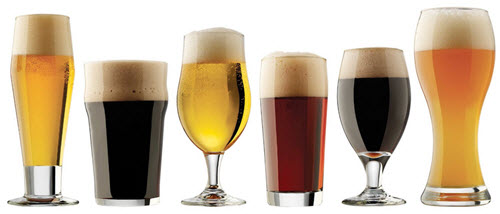The glass that a beer is served in is much more than simply a way to drink the beer. In reality, the glass is an important component of the experience. Choosing the right glass can completely change the way that a person experiences a beer, helping to enhance the overall impression of the beer, as well as the way it looks and even the way it smells. The large number of different types of glasses available can make picking the correct glassware a little difficult, but it is well worth making the effort.
Tasting Notes for West Coast (American) IPA: Green Flash, Dogfish Head, Red Hook, Stone
I was pretty excited to do my IPA tasting for two reasons. One, my ESB tasting (link) last week went really well and I think I learned a lot. But the biggest reason is that hops are a huge part of brewing craft beer (and beer in general), but I still can’t identify the various hop flavors very well. The difference between floral, grassy, citrusy, earthy, and other hop flavors is still a mystery to me.
How to Roast Your Own Malt At Home
As a homebrewer, one good way to make your beer a little more personal is to roast your own malts. Roasting malts is a surprisingly easy process that doesn’t take more than an hour and can add a unique quality to your beer that you would not have otherwise. Home roasted malt lacks the consistency that is present within professionally roasted malts, but honestly, the unique nature of home roasted malt more than makes up for this.
Get Based: Typical Styles of Base Malts Explained
There are many factors that differentiate beers from one another and the grain used plays a strong role in beer. Choosing your base malt will decide the direction of your beer. They generally make up for the majority of your malt profile, and will produce the most of your sugars that will ultimately be converted into alcohol.
Gluten Free Brewing at Home
Even though the majority of grains used in brewing beer contain gluten, including wheat and barley, it is entirely possible to brew gluten free beer at home. Doing so involves taking advantage of grains that do not contain gluten, which include millet, buckwheat, quinoa, rice, corn and sorghum. However, brewing gluten free beer is a bit more challenging than traditional brewing and takes additional work.



